Home > magnificent > Magnificent Antique Bent Slag Panel Glass Lamp Shade Bradley & Hubbard E Miller
Magnificent Antique Bent Slag Panel Glass Lamp Shade Bradley & Hubbard E Miller
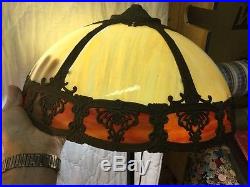
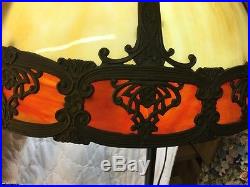
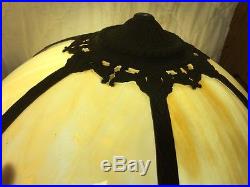
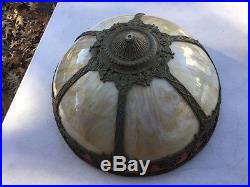
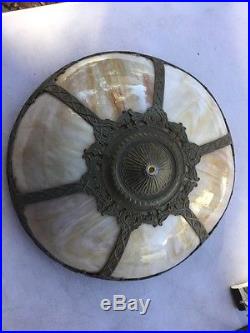
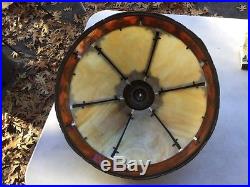
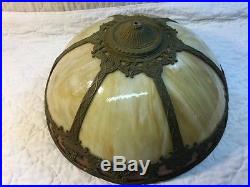
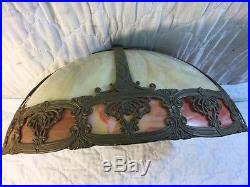
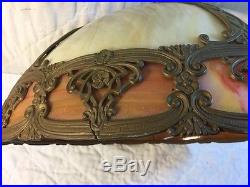
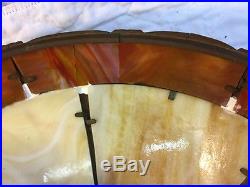
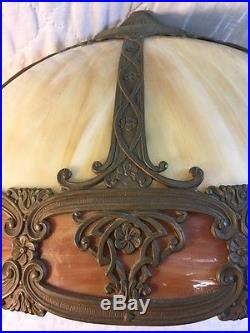
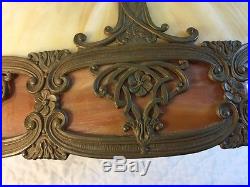
Magnificent Antique Bent Slag Panel Glass Lamp Shade Bradley & Hubbard E Miller Era. I could not find a mark but certain it was made by one I mentioned or perhaps Rainaud, Pittsburgh or other famous makers from 1910 era. Measures 16 3/8″ wide and about 9″ high. It has 12 glass panels – 6 caramel slag and 6 red orange slag. The caramel colors panels are fine, one of the red orange color panels has a single crack. A previous owner added to the inside a few drops of white putty to keep the panels from rattling and coming loose – it is only visible from the inside and it actually makes perfect sense. The metal filagree is 100% complete, the lower edge has 6 sections and 3 of these areas have a small tight age crack but again nothing missing and all the panels are held tight – my 12 photos should show this shade in detail. Guaranteed an authentic 1910 era Art Nouveau table lamp shade in the classic tradition and most likely Bradley & Hubbard. We are listing a lamp base that we acquired with this shade but it looks like it was a marriage which is why we are listing is separately. Slag glass, also known as marble glass or malachite glass, is a type of opaque, streaked pressed glass. Production of slag glass originated in late-19th-century England, where glass manufacturers are thought to have added slag from iron-smelting works to molten glass to create a range of effectsfrom tortoiseshell to marbling. Among other uses, slag glass was a popular material for lampshades. One of the first glass foundries to produce slag glass (although it was not called that at the time) was the Gateshead, England, firm of Sowerby, which patented its recipe for purple malachite glass in 1878. Market as “blackberries and cream, ” this popular formula was followed by other malachite colors, including a lemon-yellow called Giallo, a drab green called Pomona, a blue malachite called Sorbini, and Sowerbys famous Brown, which is very difficult to find today. Since the process of making slag glass was shrouded in a certain amount of mystery, stories sprang up to try and account for the process behind the effects. For example, it was a good bet that Sowerbys Blue Nugget color of 1883 was the result of adding cadmium to molten glass, but how to explain Gold Nugget? Stories soon spread that John George Sowerby, son of the companys founder, was tossing gold sovereigns into batches of amber glass to create this dramatic hue. In the United States, manufacturers such as Westmoreland and Akro Agate picked up on the techniques developed in England and produced their own versions of slag glass. As in England, one of the most popular applications for their pressed opaque glass was in lampshades. Wide bands of creamy colors allowed the light source in a lamp to fill a room with a soft ivory glow, while the purples and greens and reds pieced together in detailed leaded shades resulted in multi-colored illumination. Just about anyone who was making lamps during the Art Nouveau period, from Tiffany to Roycroft to Steuben, might have used slag glass in their shades. But whether they did or not in a particular lamp is another matter. The problem is that today, “slag glass” is used rather casually by dealers and collectors alike to refer to almost any type of pressed opaque glass containing colored swirls or streaks. The key to determining if a piece of glass is “true” slag or just a handsome example of pressed glass is to look for glass that is obviously and richly marbled rather than simply colored or streaked. The item “Magnificent Antique Bent Slag Panel Glass Lamp Shade Bradley & Hubbard E Miller” is in sale since Sunday, November 20, 2016. This item is in the category “Antiques\Decorative Arts\Lamps”. The seller is “spooknook” and is located in Weymouth, Massachusetts. This item can be shipped to United States.
- Primary Material: Glass
Comments are closed.
-
Category
-
Links
-
Meta
-
Archive
- April 2024
- March 2024
- February 2024
- January 2024
- December 2023
- November 2023
- October 2023
- September 2023
- August 2023
- July 2023
- June 2023
- May 2023
- April 2023
- March 2023
- February 2023
- January 2023
- December 2022
- November 2022
- October 2022
- September 2022
- August 2022
- July 2022
- June 2022
- May 2022
- April 2022
- March 2022
- February 2022
- January 2022
- December 2021
- November 2021
- October 2021
- September 2021
- August 2021
- July 2021
- June 2021
- May 2021
- April 2021
- March 2021
- February 2021
- January 2021
- December 2020
- November 2020
- October 2020
- September 2020
- August 2020
- July 2020
- June 2020
- May 2020
- April 2020
- March 2020
- February 2020
- January 2020
- December 2019
- November 2019
- October 2019
- September 2019
- August 2019
- July 2019
- June 2019
- May 2019
- April 2019
- March 2019
- February 2019
- January 2019
- December 2018
- November 2018
- October 2018
- September 2018
- August 2018
- July 2018
- June 2018
- May 2018
- April 2018
- March 2018
- February 2018
- January 2018
- December 2017
- November 2017
- October 2017
- September 2017
- August 2017
- July 2017
- June 2017
- May 2017
- April 2017
- March 2017
- February 2017
- January 2017
- December 2016
- November 2016
- October 2016
- September 2016
- August 2016
- July 2016
- June 2016